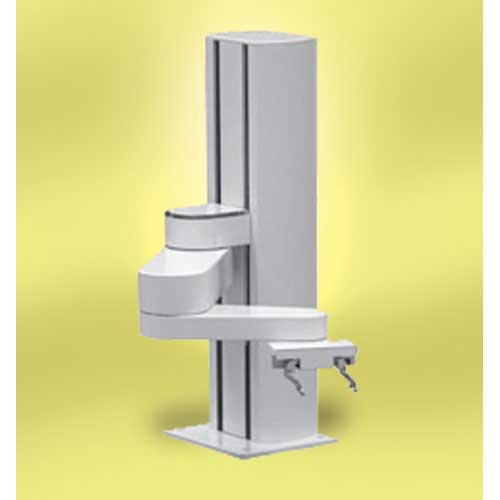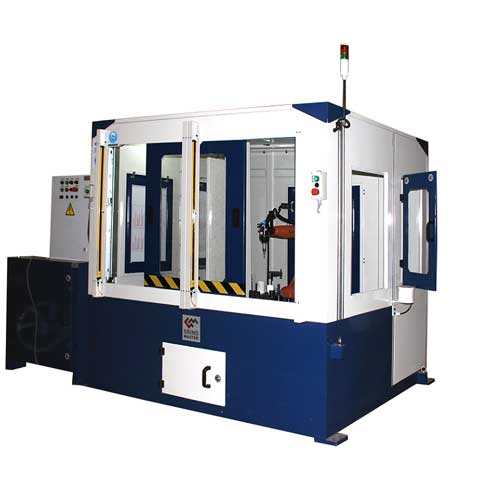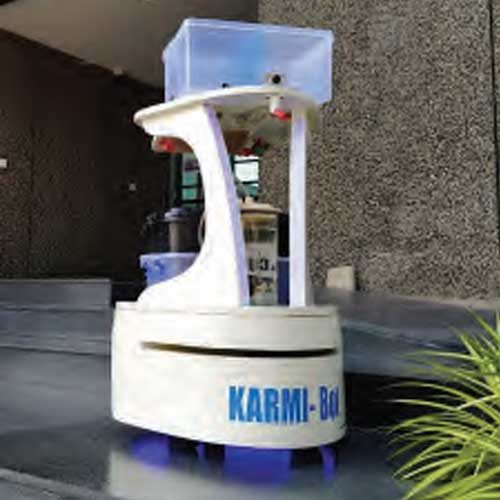Schedule a Call Back
Classification of industrial robots
 Technical Articles
Technical Articles- Nov 30,-1

In this second and concluding part of the article Dr K C Jain explains the classification of industrial robots.
Robots vary in size, shape and complexity of operation. Industrial robots classification is given as under:
Cartesian or rectangular configuration
The Cartesian configuration provides for three linear axes of movement at right angles (sometimes termed orthogonal) to each other. The modes of movement are similar to those of a milling machine, providing movement in X, Y and Z axes. It may also be termed a rectangular configuration since its working range sweeps out a three-dimensional rectangular volume. (See Fig. 6.5.7(a)
Cylindrical configuration: The cylindrical configuration combines both vertical and horizontal linear movement, with rotary movement in the horizontal plane about the vertical axis. It is so called because its motions sweep out a partially cylindrical working volume. [See Fig 7 (b)]
Polar or spherical configuration: The geometry of the spherical configuration combines rotational movement in both horizontal and vertical planes with a single linear (in/out) movement of the arm. It may occasionally be referred to as a ‘gun turret’ configuration. Whilst this configuration occupies and sweeps out a relatively large volume, the access of the arm within this total volume is restricted. [See Fig 7 (c)].
Articulated or revolute configuration: The articulated revolute configuration consists of a number of rigid arms connecting rotary joints. Rotary movement around the base is also provided. It is sometimes referred as a ‘jointed-arm’ configuration or, because it resemble the movements of the human body, it may also be termed as ‘anthropomorphic’ configuration. Certain configurations may have either an open kinematic structure or a closed kinematic structure. [See Fig 8 (a)].
Spine configuration: The spine configuration appears as a single arm fully enclosed by a flexible protective gaiter. One method of actuation consists of a series of motorised universal joints, which can be built up in modular fashion to the required length. A second method of actuation utilises stainless steel, strung together on two sets of tensioned steel cables. It has relatively low payload capacity. This configuration is suitable to awkward products and situations for welding, riveting and remote handling of dangerous products. [See Fig 8 (b)].
Pendulum configuration: The pendulum configuration combines a single linear motion with two perpendicular rotary movements. The relatively simple design combines fast and efficient operation with high payload capacity. The design is robust extremely compact and offers great versatility in mounting arrangements.
Classification on the basis of motion control
Manipulator is made up of links called actuators that make the robot links to move and perform the task. Actuators use various electro mechanical systems such as cylinders rack and pinion screw mechanism motors, harmonic drives and chain drives.
Non servo controlled point-to-point motion: In this class of robot motion is uncontrolled and non-linear between the points at which the robot is programmed to stop and do something. The motion is sometimes called limited sequence.
Servo controlled point-to-point: In servo controlled robots it is possible to programme one point after another, storing each, as the movement is carried outs not only the distance between the each point but the velocity of the movement can also be programmed controlled.
Servo-controlled continuous path: The basic method of programming and controlling the path movement is same of the previous one except the fact that its movement is rapid and at higher frequencies, i.e., 60 to 120 Hz or even higher and automatic. In the previous case it was done manually.
Continuous path controlled: Continuous path controlled robot can be programmed for any path such as an arc, circle or zig-zag movement.
Classification on the basis of power supply control
There are three types of power drives, i.e., Pneumatic, Hydraulic and Electric.
Pneumatic drives: Power supply or the drives means the actuators of the robot system are powered. Compressed air from tanks at 1380 kpa (200 psi) and is piped at 550-860 kpa (80-125 psi) to actuate the manipulator.
Hydraulic drives: In this case actuators work through the use of hydraulic cylinders operated linearly. These cylinders operate at 6900 kpa (1000 psi); thus much greater force can be transmitted as compared to pneumatic actuators.
Electric drives with non-servo drives: The motion of the manipulator is controlled by the actuator movement that controls the link motion. This motion is controlled by switches and stops then it is non-servo controlled drive. Nevertheless pneumatic and hydraulic driven actuators use servo valves, where as electrical energy driven actuators use servo motors most of the servo-systems contain a controller, an amplifier, servo mechanism, feedback transducers and comparator.
Classification on the basis of physical characteristics
Robots vary in size, shape and complexity of operation of robots.
Manual manipulation: Such types of robots are directly operated by a man or a woman. The capability of the robot is possessed by the operator. Thus increasing the operators reach and sifting capabilities.
Remote controlled robot: Such manipulators are used for carrying out operations from distance such as of tasks to be carried out in hazardous environment.
Programme controlled robots: Such robotic system is characterised to possess a manipulator system that can be programmed to control each of the actuators in a manipulator as to achieve pre-defined assembly tasks, trajectory planning end effector control. Control of these tasks are to be performed in real time.
Play back robot: This type of robot is same as master slave operator, with a difference that the masters movement are recorded on magnetic tape on flexible disc and the robot will duplicate the operators movements when placed in the play back mode.
Fixed and variable sequence robots: In case of fixed sequence robots the predetermined sequences cannot be easily altered while the variable sequence robot provided some flexibility.
Application of industrial robots
Industrial robots are having wide range of applications in industry. Following application, are provided to have a general view of the range of industrial robots:
Robot specifications
Whenever one moves to a robotic system for its utility in the industrial/manufacturing tasks, he must be able to specify what type of a robot is required. In view of the proposed requirement following specifications should be mentioned:
| 1 | Model and Series | PUMA-550 or PUMA-560 Wiper 250, 3000 UK, etc. |
| 2 | Controller | Fanuc, Quantec Pro. |
| 3 | Teach pendant | Yes or Programmable |
| 4 | Reach – Maximum | e.g., 2500 mm or 3000 mm |
| 5 | Rated pay load | e.g., 120/150/200 kg. |
| 6 | Rated suppl. load – Link/arm/colour, etc. | e.g., 50/60/65 kg. |
| 7 | Rated total load | (5+6) |
| 8 | Resolution, accuracy, repeatability etc. | As required |
| 9 | Number of axes | 6 or 7 |
| 10 | Mounting | As required |
| 11 | Total weight | Ambient working temperature |
| 12 | Operating condition | Ambient working temperature |
(b) Specification for axes: Angles of rotation and speed (Ref Fig 10)
| Range of motion | Speed with rated pay load 120 kg | Speed with rated pay load 90 kg |
| Axis - 1 (Z) ± 185o= 270o | 130o/S | 130o/S |
| Axis - 2 (X) ± 75o,-120o = 195o | 130o/S | 130o/S |
| Axis - 3 (Y) + 160o, - 120 = 280o | 110o/S | 110o/S |
| Axis - 4 (Yaw) + 45o, - 15o = 60o | 260o/S | 260o/S |
| Axis - 5 (Pillar) – 90o, - 50o = 140o | 240o/S | 240o/S |
| Axis - 6 (Roll) + 180o, - 90o = 270o | 290o/S | 290o/S |
With reference to 3 and 10 the angles of rotation of base, joint number (2), joint number (3) and the angles of rotation of tool plate, i.e., angles of pitch, roll and yaw.
Related Stories

The role of risk management in large projects
Risk is inseparable from project management, particularly in large and long-duration projects, where inadequate risk identification, ownership and follow-up often lead to cost and time overruns. Pra..
Read more
HCLTech Expands Partnership with Aurobay Technologies Global
HCLTech and Aurobay Technologies expanded their partnership, with HCLTech managing SAP, PLM and integration services in Sweden and China to drive efficiency, resilience and digital innovation global..
Read more
India EV Battery Demand to Surge 14-Fold by 2032: CES Report
CES says India’s EV battery demand may rise from 17.7 GWh in 2025 to 256.3 GWh by 2032, driven by electrification, new models, fuel prices and policy support shaping growth over next seven years t..
Read moreRelated Products

Collaborative Scara Robot
Malles Automated & Robotic Systems Private Limited

Robotic Deflashing of Aluminium Casting
Grind Master Robotic Deflashing Machine is an advanced and most reliable machine for Aluminium components. Robotic deflashing is a revolutionary technology developed by Grind Master Machines Pvt Lt Read more

Karmi Bot
Asimov Robotics offers a wide range of Karmi Bot.












